Technical Specifications
The information in this document applies to version 7.0.13 of Syhunt Hybrid.
Table of Contents
This document presents the technical specifications of Syhunt Hybrid, an augmented HAST (Hybrid Application Security Testing), DAST (Dynamic Application Security Testing), SAST (Static Application Security Testing), MAST (Mobile Application Security Testing) and DWET (Dark Web Exposure Testing) tool of high accuracy, depth and coverage that identifies vulnerabilities and weaknesses in applications, and data leaks related Internet domains.
a. License Rights
- Syhunt Hybrid software licenses usually have a term of validity of 12 months.
- The licenses include version update and technical support rights, in addition to providing technical documentation in English in PDF and HTML formats.
- The licenses allow an unlimited number of scans against an unlimited number of Assets per year, which must be launched from a single device or (if additional seats are ordered) more Customer devices. Each license include two web interface users - an admin and a secondary user. Additional users can be purchased if needed, expanding the number of users.
- Some licenses include support for scanning applications written in all programming languages, while others support at least one programming language. If necessary, additional languages can be purchased to expand the number of supported languages.
- The licenses allow the integration of the tool with AI (Artificial Intelligence) through the configuration of an API key, which for data control and privacy reasons, must be received and purchased separately and directly from an AI supplier supported by the tool. Syhunt currently only supports OpenAI.
b. Architecture
Syhunt Hybrid is an application security assesment software tool, which is hybrid, on-premise, modular, asynchronous and multi-process:
- It is hybrid, that is, it combines different analysis techniques, such as DAST, OAST, SAST, MAST, FAST and DWET (detailed below).
- It is on-premise, that is, the solution is deployed on the Customer's premises, so that the analyzed source code and analysis results do not leave its internal network.
- It is modular with a single management console that aggregates the configuration management features of its modules and analysis results presentation features.
- It is asynchronous, that is, the solution works with several scans simultaneously, without the need of waiting for the end of each analysis.
- It is multi-tabbed and multi-process, that is, each browser tab or scan is a different process in the operating system.
- It comes with a responsive web interface and a command line interface (CLI) that allows the launching of dynamic and source code scans and other tasks.
Supported Types of Analysis
Syhunt Hybrid performs the following types of analysis:
| SAST | Static analysis of the security of a web application's source code |
| MAST | Static analysis of the security of a mobile application's source code (Android & iOS) and Android APK file |
| DAST | Dynamic analysis of the security of a web application security with deep crawling and parameter injection |
| OAST | Augmented dynamic analysis of the security of a web application security with out-of-band (OOB) techniques |
| HAST | Hybrid-Augmented analysis of the security of web applications, on which the results of the static analysis are automatically used to enhance its augmented dynamic analysis |
| DWET | Surface to dark web exposure scoring of Internet domains |
| FAST | Forensic analysis of the security of a web application through the analysis of web server log files |
Vulnerability Database
Syhunt currently comes with an internal vulnerability database that contemplates the sets of publicly available vulnerabilities and regulations listed in the table below. The tool's vulnerability database is updated periodically, ensuring that the solution is always up-to-date with new vulnerabilities published by international vulnerability databases.
| CWE/SANS Top 25 2023 | Most Dangerous Software Errors: 2023 version or later |
| OWASP Top 10 2021 | Top 10 Web Application Security Risks: 2021 version or later |
| OWASP Mobile Top 10 | Mobile Top 10 Risks: 2024 version or later (PLUS) |
| OWASP PHP Top 5 | |
| CWE | Common Weakness Enumeration |
| CVE | Common Vulnerabilities and Exposures |
| ISO/IEC 27001 | |
| WASC | The Web Application Security Consortium Threat Classification |
| WAVSEP | Web Application Vulnerability Scanner Evaluation Project |
| NIST SAMATE | Software Assurance Metrics And Tool Evaluation Project |
| PCI DSS | Payment Card Industry Data Security Standard: version 3.2, 3.2.1 or later |
Integrations
Syhunt Hybrid comes with features for integration with the following systems and software:
| Ticket Management / Issue Tracking | JIRA: 7.13.0 or later GitHub GitLab |
| Version Control | Public and private GIT repositories Azure DevOps and TFS repositories (TFVC & GIT) GitHub and GitLab Branches |
| APIs & Scripting | Lua 5.1 API Web API (REST) PowerShell JSON and XML Selenium |
| Security Dashboards | OWASP DefectDojo GitLab Security Dashboard Faraday |
| Application Vulnerability Management | BIG-IP Application Security Manager (ASM) Imperva SecureSphere ModSecurity CRS OGASEC WAF |
| Development Process Control | GitHub Actions, GitLab CI and Security Dashboard Jenkins Pipeline |
| Web Browsers | Syhunt Sandcat (Built-In) Google Chrome Mozilla Firefox |
| SMTP |
The examples below show how to perform the analysis of a GIT repository through the various available integration options:
-- from the command prompt
scancode git://sub.domain.com/repo.git
scancode https://github.com/user/repo.git -rb:master
scancode https://dev.azure.com/user/projectname
-- from GitLab CI Script
- Start-CodeScan -pfcond 'fail-if:risk=mediumup' -output 'report.pdf' -outputex 'gl-sast-report.json'
-- from GitHub Actions Script
- Start-CodeScan -pfcond 'fail-if:risk=mediumup' -output 'report.pdf'
-- from Jenkins pipeline script
syhunt.scanCode([target: 'https://github.com/someuser/somerepo.git', branch: 'master', pfcond: 'fail-if:risk=mediumup'])
-- from PowerShell
$MyScan = @{
target = 'https://github.com/someuser/somerepo.git';
branch = 'master';
pfcond = 'fail-if:risk=mediumup';
output = 'report.pdf'
}
- Start-CodeScan @MyScan
-- from Lua script
code:scanurl('https://github.com/someuser/somerepo.git', 'master')
-- from Web API (REST, raw JSON)
-- POST /syhunt/launch.lua
{
sourcetarget: "https://github.com/someuser/somerepo.git",
sourcebranch: "master",
apikey: "YOUR_API_KEY"
}
Supported Languages & Environments
Syhunt Hybrid identifies vulnerabilities in applications with the following languages, environments and frameworks:
| Language | Environment / Framework |
| C# | ASP.Net |
| Java | JEE JSP Android Spring Framework |
| JavaScript | Client-Side Server-Side Node.js (Barebone, Express.js & Koa.js) Angular (version 2 or higher) AngularJS JScript (ASP Classic) ElectronJS (Desktop) |
| Kotlin | Ktor |
| Lua | ngx_lua mod_lua CGILua Lua Pages |
| Objective-C, C & C++ | iOS |
| Object Pascal | Delphi Delphi XE Lazarus DWS |
| Perl | |
| PHP | |
| Python | CGI mod_python PSP WSGI Django |
| Ruby | Rails ERB mod_ruby |
| Swift | iOS |
| TypeScript | |
| VB | VB.Net (ASP.Net) VBScript (ASP Classic) |
c. Source Code Analysis
| Module Name | Syhunt Code; Syhunt Mobile |
| Description | Analyzes the source code of web and mobile applications for security vulnerabilities |
| Type of Analysis | SAST (Static Application Security Testing) MAST (Mobile Application Security Testing) |
| Target Applications | Web Applications (including Web Services) Mobile Applications (Android & iOS) Desktop Applications |
| Target Languages & Platforms | APK (Android) ASP.Net & ASP Classic HTML Java (including Android) JavaScript Kotlin (including Android) Lua Objective-C, C & C++ (iOS) Object Pascal (Delphi) Perl PHP Python Ruby Swift (iOS) TypeScript |
| Vulnerabilities Detected | 1300+ |
| Vulnerability Categories Covered | 40+ |
| GIT Integration | Yes |
- It comes with known application vulnerabilities in all programming languages and environments supported by the module.
- Supports code embedded in HTML, print shorthands and string interpolation.
- Identifies client-side and server-side vulnerabilities.
- Identifies the use of outdated vulnerable scripts, local or remote, such as vulnerable versions of AngularJS, jQuery, fullPage, Bootstrap and momentjs.
- Performs vulnerability analysis on complete source codes, code snippets and configuration files.
- Performs incremental analysis, on which key results and data from scans against a specific codebase are automatically stored and used to speed up future scans.
- Supports multi-auditing of several programming languages in the same scan session.
- Supports TypeScript, allowing it to detect vulnerabilities before the code is compiled to JavaScript (Client and Server-Side, Node.js & Angular).
- Identifies and allows to navigate through key areas of code, such as specific HTML markers, JavaScript, XHR requests, entry points and interesting keywords.
- Identifies vulnerabilities in poorly designed code, that is, programming errors that expose the system to attack risks.
- Analyzes configuration files to assess security threats and identify appropriate countermeasures at the stage of server, environment or application configuration.
- Recognizes cases of input filtering and validation, providing accurate and false-positive free results.
- Includes AI-Powered feature that adds to reports examples of fixed code along with each vulnerable code identified during the scan.
Syhunt Code User Interface
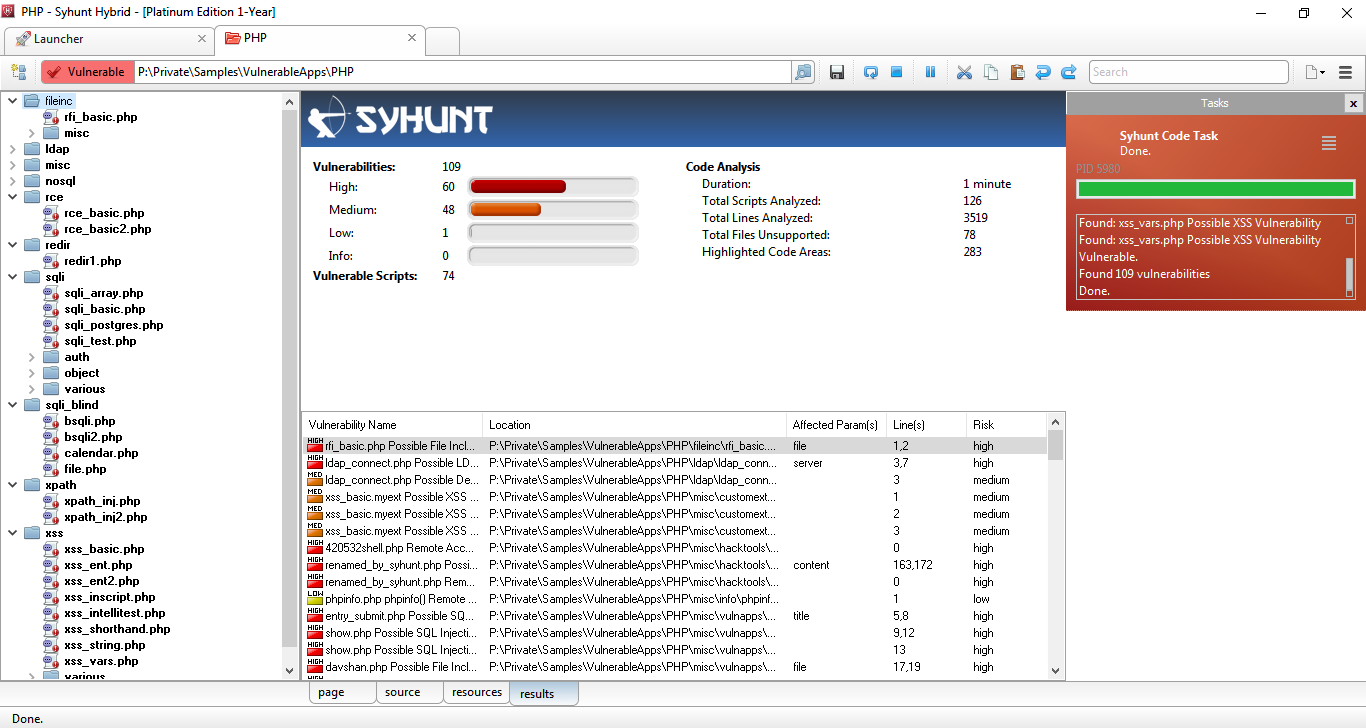
The Syhunt Code's user interface allows real-time viewing of the status of running scans, including:
- Tree of analyzed and vulnerable files:
- Scan duration;
- Total scripts analyzed and vulnerable;
- Total vulnerabilities found and by severity level;
- Total lines analyzed;
- List of vulnerabilities found.
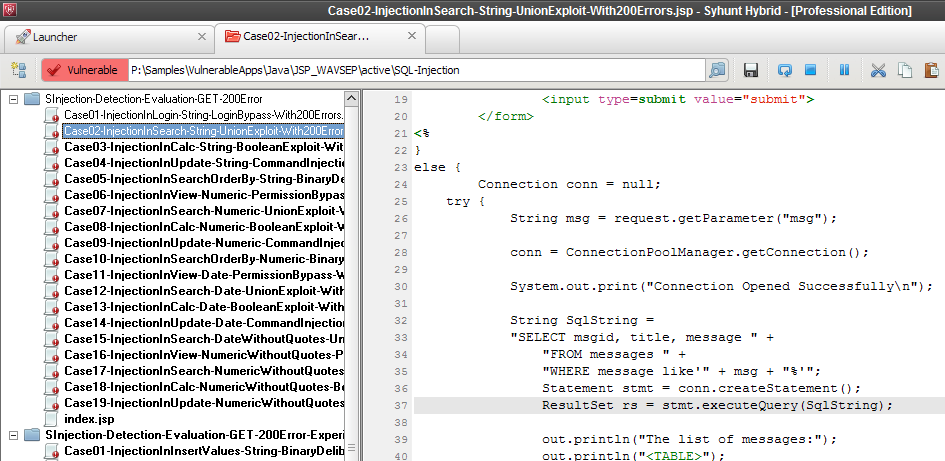
c2 Mobile Analysis
Syhunt Code performs MAST (Mobile Application Security Testing) in Android and iOS applications and Android APK files for pressing OWASP Mobile Top 10 and CWE/SANS Top 25 risks, such as:
- Improper Credential Usage;
- Inadequate Supply Chain Security;
- Insecure Authentication/Authorization;
- Insufficient Input/Output Validation;
- Insecure Communication;
- Inadequate Privacy Controls;
- Insufficient Binary Protections;
- Security Misconfiguration;
- Insecure Data Storage;
- Insufficient Cryptography
d. Dynamic Analysis
| Module Name | Syhunt Dynamic Augmented |
| Description | Detects security vulnerabilities in dynamic web applications and web servers |
| Type of Analysis | DAST (Dynamic Application Security Testing) OAST (Out-of-Band Application Security Testing) |
| Target Applications | Web Applications & Web Servers |
| Target Languages & Platforms | ASP.Net & ASP Classic HTML & JavaScript Java Lua Perl PHP Python Ruby |
| Optimized Analysis for HTTP Servers | Apache Apache Tomcat Microsoft IIS Nginx Openresty |
| Vulnerabilities Detected | 7000+ |
| Vulnerability Categories Covered | 68+ |
| Injection Checks | 570+ |
| Supported Protocols | HTTP version 1.0 & 1.1 HTTPS (SSL 2/SSL 3/TLS 1/TLS 1.3) IPv6 Proxy (HTTP, Socks 4 & Socks 5) |
| Supported HTTP Methods | Keep-Alive GZIP Compression Authentication: Basic, Bearer, MD5/SHA256/SHA512, Form-Based & NTLM* |
*NTLM / Kerberos: NTLM support only available for Microsoft Windows. Kerberos support is planned.
- It comes with known web application vulnerabilities in the programming languages and environments supported by the module.
- Performs augmented dynamic analysis, a combination of DAST and OAST test methods.
- Performs hybrid-augmented analysis, a combination of DAST, OAST and SAST test methods.
- Performs incremental analysis, on which key results and data from scans against a specific target URL are automatically stored and used to speed up future scans.
- Performs AI-powered form authentication, automatically detecting how to login with provided credentials and instructions, caching a successful login procedure to be used in future scans.
- Automatically indicates in reports when an authenticated session was maintained from the start to the end of an authenticated scan.
- Identifies the use of outdated vulnerable scripts, server software and other components.
- Identifies client-side and server-side vulnerabilities.
- Identifies in-band, inferential and out-of-band (OOB) vulnerabilities.
- Identifies known, vulnerable applications in all programming languages supported by the solution, including ColdFusion, Flash & Server Side Includes (SSI).
- Automatically performs structural, login form and HTTP authentication brute-force attacks.
- Automatically detects logout pages within the target web application, preventing accidental logout during a scan, with optional manual configuration option.
- It comes with invasive and non-invasive scanning capability.
- Allows to turn off denial of service (DoS) tests that may affect the availability of the web application.
- Allows to configure the number of retries and timeout used to connect to the web application.
- Supports analysis of applications built on top of content management systems, such as Drupal, Joomla, WII and WordPress.
- Supports analysis of SPAs (Single Page Applications).
- Supports Selenium scripting (Python-based) in authentication phase.
- Identifies the technologies used in the application and optimizes the scanning time based on the detected technologies.
- Identifies the hidden versions of server software and components (Hunter-Sense™), such as Apache, Nginx, PHP, mod_ssl, OpenSSL and Phusion Passenger.
- Performs data injection and manipulates parameters in the target application in URLs and forms (both GET and POST).
- Performs injection mutations, in order to cover all programming languages and target platforms supported by the solution.
- Performs time-based injection checks with a 0% false-positive rate. This applies to Code Injection, Expression Language Injection, NoSQL Injection, Remote Command Execution and SQL Injection checks.
- Identifies vulnerabilities such as SQL injection,NoSQL injection, OS Command Injection, exposure and code injection through techniques such as inferential (response time), in-band (error message or print), out-of-band (OOB) and Passive Analysis.
- Includes an AJAX Crawler that can be enabled and allows deep crawling of AJAX-heavy web applications created with the most popular frameworks, including Angular, AngularJS and React.JS. This includes Pre-rendering capability and Local Storage support.
Browsing and Crawling Capabilities
Syhunt Hybrid maps the structure, including all links and entry points of the target application, while emulating a modern browser with support for the following standards, features and Web 2.0 technologies:
| Latest Web Standards | HTML 5 CSS 3 |
| Intelligent HTML Analysis | Relative Paths Standard HTML Non-standard or deformed HTML Form Recognition |
| Browser Emulation | Google Chrome Mozilla Firefox Microsoft Edge Referer Submission Pre-rendering Local Storage |
| JavaScript Support | JavaScript analysis and execution DOM Emulation Browser Behavior XHR (XMLHttpRequest) Calls / AJAX Support for external JavaScript files |
| User Interaction Simulation | Key press Mouse clicks Autofill forms Automatic login Accidental logout prevention |
| Cookies Support | Cookie management Session management |
| Follow Redirects | HTTP Meta refresh JavaScript |
| Process Isolation | Each browser or scan tab is a different process in the system |
| Robots.txt File Analysis | If the file is available |
Syhunt intelligently handles large, complex websites with dynamic content generation and includes mechanisms to prevent loop situations during application mapping. In addition, it allows to limit the depth of scans, including:
- Maximum number of links per server and links per page
- Maximum URL size in bytes and HTTP response in kilobytes
Site Preferences
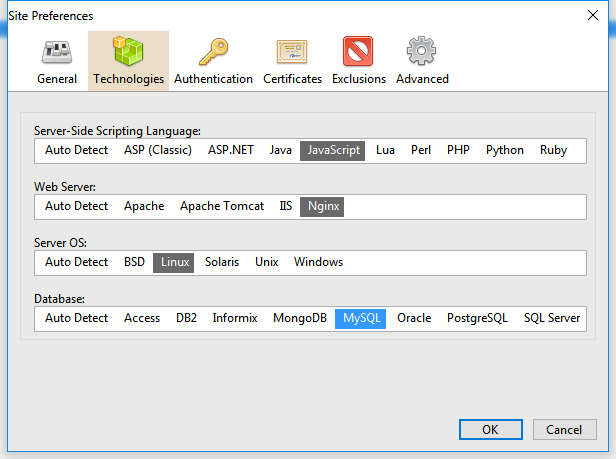
- Technologies used by the application in order to optimize the scanning time, such as the server-side language, the web server, the operating system and the database of the target application;
- Start URLs;
- SSL certificates and credentials for authentication allowing to perform the analysis logged in the target system (basic and web form-based);
- Exclusion of objects from scanning, such as specific paths, forms and vulnerabilities;
- Depth and layer limitation
- Signatures for detecting custom 404 error pages;
- Manual configuration of cookies and session token.
Syhunt Dynamic User Interface
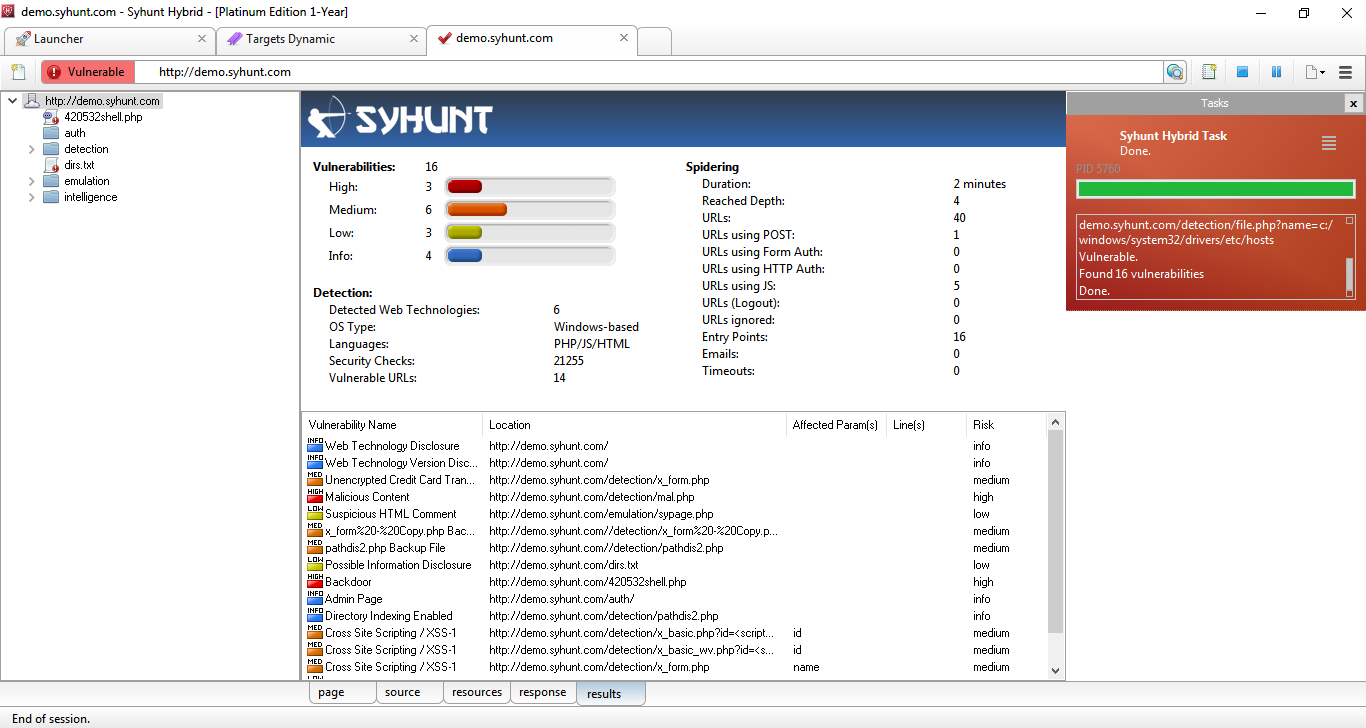
- Site tree of found and vulnerable paths (sitemap and web site structure);
- Scan duration;
- Total vulnerable URLs;
- Total URLs using POST, authentication and JavaScript;
- Total entry points;
- Total timeouts;
- Total vulnerabilities found and by severity level;
- Total security checks performed;
- Detected web technologies;
- Target operating system type;
- Target programming languages;
- Depth Reached;
- List of vulnerabilities found.
Built-In Web Browser
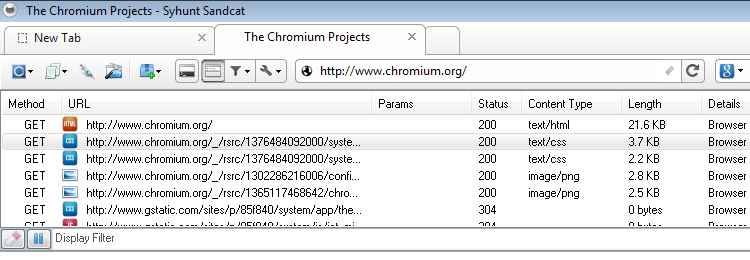
- Manual login to web applications
- Perform scan after authenticating using CAPTCHA, tokens and other two factor authentication mechanisms
- Perform scan after manual crawl / navigation
- Capture URLs and entry points
- Live HTTP headers
- Preview capability for the most common web file formats, such as CSS, Flash, HTML, common image formats (bmp, gif, ico, jpg, png and svg), JavaScript, JSON, text and XML
- Automatic JavaScript deobfuscation
- Request replay capability
- Fuzzer
- Script executor
- HTTP and XHR editors and request loader.
d2. Augmented Analysis
| Module Name | Syhunt Signal |
| Description | Detects out-of-band security vulnerabilities in dynamic web applications |
| Type of Analysis | OAST (Out-of-Band Application Security Testing) |
| Target Applications | Web Applications |
Syhunt Dynamic Augmented integrates with the online Syhunt Signal service to perform automated OAST (Out-of-Band Application Security Testing):
- Allows the scanner to detect otherwise invisible, high-risk out-of-band (OOB) vulnerability variants
- Listens to forced requests coming in from a vulnerable target web server over the course of a scan and signals back to the scanner.
- Automatically correlates the received alerts with attack requests it launched.
- Adds the identified OOB vulnerabilities to its report and user interface.
- Returns zero false positives.
- Automatically exfiltrates data from a vulnerable target, which gets added to the scan results, using different commands and techniques (environment and OS-specific).
- Needs an active Internet connection to work.
The following out-of-band vulnerability types are detected by Syhunt Signal:
| Command Execution |
| Remote File Inclusion (RFI) |
| Server-Side Request Forgery (SSRF) |
| SQL Injection |
| XML External Entity (XXE) Injection |
d3. Hybrid-Augmented Analysis
Syhunt Hybrid combines the results of Syhunt Dynamic, Syhunt Signal and Syhunt Code to perform Hybrid-Augmented Analysis, AKA augmented HAST (Hybrid Application Security Testing), on which the results of the static analysis are automatically used to enhance its augmented dynamic analysis:
- Combines SAST, DAST & OAST test methods.
- Performs hybrid client-side JavaScript code analysis (SAST-in-DAST).
- Dynamically detects and confirms vulnerabilities by simulating inferential, in-band and out-of-band (OOB) attacks and by using entry point and other information acquired through source code analysis.
d4. Dark Web Exposure Scoring
| Module Name | Syhunt Breach |
| Description | Performs scored analysis of breaches affecting domains |
| Type of Analysis | DWET (Dark Web Exposure Testing) |
| Domains Covered | 58 million+ |
Syhunt Breach informs about data leaks on the surface, deep and dark layers of the web, including file and credential exposures, and allows to view and compare the privacy and security score of Internet domains based on their track record and testing results. Syhunt Breach is designed not to offer direct access to specific breach contents. Instead, it focuses on dynamically analyzing and mapping third-party risk.
- Informs about breach incidents of authorized Internet domains, such as leaked passwords, surface to dark web file and database leaks, and past breaches.
- Informs about the privacy score of authorized Internet domains based on identified leaks and public incident records.
- The databases cover various types of leaks and breaches, including password leaks, surface to dark web file exposures, past security incidents and ransomware group leaks.
- The databases cover over 5 billion password leaks globally.
- The databases cover over 58 million domain related leaks.
- The databases cover leaks on the surface, deep and dark layers of the web.
- The databases cover over 20.000 breach situations.
- The databases cover the 30 most dangerous and active ransomware group leaks.
d5. Forensic Log Analysis
| Module Name | Syhunt Forensic |
| Description | Detects security attacks in dynamic web applications |
| Type of Analysis | FAST (Forensic Application Security Testing) |
| Target Applications | Web Applications |
Syhunt Forensic performs on-demand security heuristic analysis of web server log files to detect attacks, including:
- Identification of origin (IP address), country, type and methods used to attempt to compromise web applications;
- Reconstruction of the attack session, accurately differentiating legitimate traffic from malicious traffic, in addition to differentiating automated attacks from manual attacks;
- Intrusion detection, with backdoor installation, and used intrusion tools.
- Detection of attempts to exploit OWASP Top 10 vulnerabilities and the use of defense evasion techniques.
- Support for log files generated by Apache, Microsoft IIS and Nginx web servers, with automatic format detection.
e. Management Console
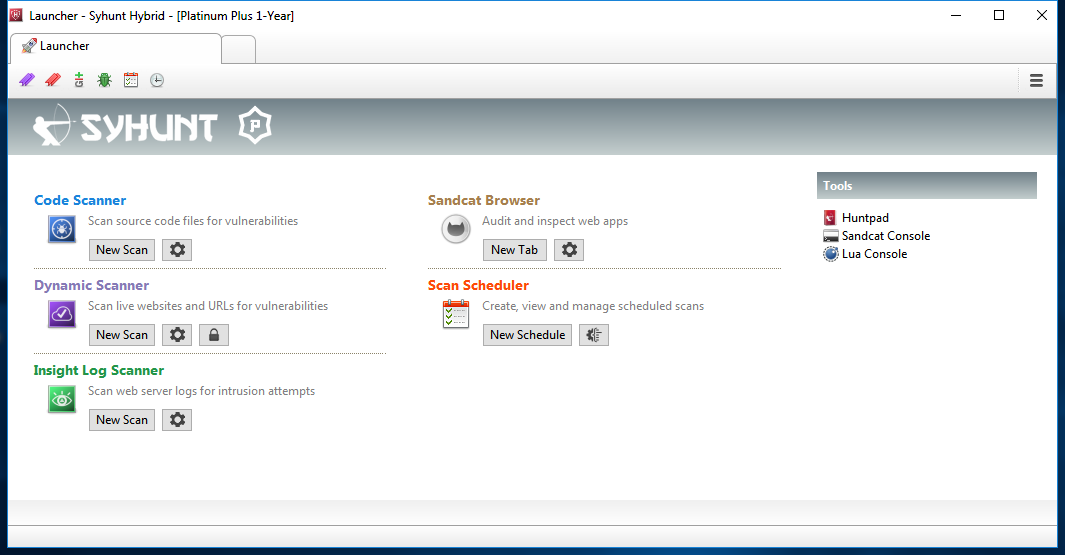
- Allows to access stored results of scans performed or in progress.
- Does not require prior knowledge of information security and secure coding to use the console.
- Requires little or no user intervention before and during the progress of scans.
- Provides a graphical view that indicates the progress of the analysis and the risk level of the analysis being performed.
- Displays software license information, showing the license type, license expiration date, and supported programming languages.
- Allows the user to disable vulnerability detection rules and identify which rules have been disabled.
- Allows the user to configure to ignore specific or multiple vulnerabilities.
- Allows pause, resume and immediate scan cancellation.
- Allows to identify, remove, export and import the results of scans performed.
- Allows to add and manage assets.
- Allows to export and import target lists from files in CSV or list format.
- Allows to export and import the current tool settings to/from a file.
- Allows real-time viewing of the list of vulnerabilities found.
- Allows to generate summary report of scans by scan methodology.
- Allows to list all sessions for a given month.
- Provides syntax highlighting for the programming languages supported by the solution.
- Includes its own notepad for manual testing, including a collection of common injection string generators, hash generators, encoders and decoders, HTML functions and text manipulation.
- Includes an Extension Development Kit (EDK) to allow the addition of new features.
Scheduling Scans
The management console allows to schedule scans with the following fields and options:
- Time, date or day of the week
- Type of Scan: Dynamic or Code
- Scan Target
- Scan time limit
- Report generation with selection of report template
- Sending a report by email after the analysis is finished
- Sending notifications to issue trackers or a security dashboard
- Option to set fail Condition based on minimum severity
- Option to perform a hidden scan (without window)
- Option to export command line to be used in third party schedulers or other tools
Vulnerability Alerts
The management console allows editing and viewing a vulnerability alert, including changing the state, severity, and inserting comments on the vulnerabilities found.
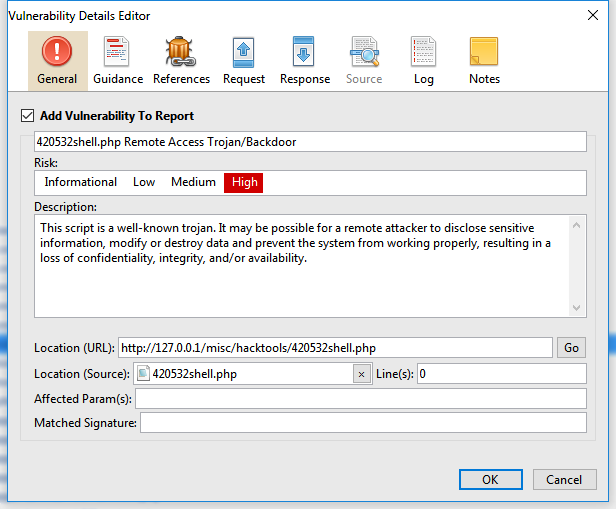
- Vulnerability name
- Vulnerability description;
- Vulnerability location, which can be a URL or file.
- Reference code for known vulnerability bases, such as CVE, CWE, NVD, OSVDB, if any;
- CVSS score: version 2 and 3;
- Severity level (High, Low, Medium or Informational);
- Unique Syhunt check ID;
- Track ID - an unique vulnerability ID per scan executed by Syhunt;
- Remediation guide;
- The affected parameters and variables;
- Affected line numbers;
- A short extract from the vulnerable source code, when applicable;
- Remediation code examples, when applicable;
- Request, Headers and HTTP Response, in case of dynamic analysis;
- Exfiltrated data (if any);
- User notes
f. Scan Features
Reporting and Results
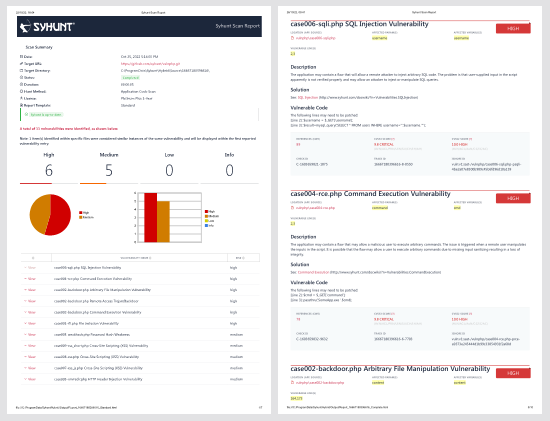
- Allows to perform pass/fail testing based on the severity of the vulnerabilities identified.
- Allows the comparison between two scans performed against the same target or source code, presenting the differences through a report and the management console that indicates the differences, such as new, unchanged or removed vulnerabilities.
- Allows to generate reports in the following supported languages: English, German, Spanish, French, Italian, Japanese, Korean and Portuguese, in which vulnerability descriptions and solutions are also translated.
- Allows automatic sending of analysis results to a selected email address.
- Generates alerts for each type of unique vulnerability that is identified.
- Confirms whether an application's security breach has occurred from a trace.
- Supports the CVSS (Common Vulnerability Scoring System) standard version 2.0 and 3.0, to communicate the severity of a vulnerability and help determine the urgency and priority of the security response, including base score and other metrics.
- Generates reports in different formats, including the formats: PDF and HTML (for reading) and XML, JSON and CSV (to be processed by other tools).
- Generates responsive HTML reports optimized for mobile, tablet and desktop sizes.
- Performs automatic grouping of similar instances of vulnerabilities into a single item.
- Sorts vulnerabilities based on CVSS3, CVSS2 (ranging from 0.0 None to 10.0 Critical) or Four Severity Steps (high, low, medium or informational).
- Allows to create custom reports with custom title, logo, notes, footer and multiple templates and sections based on user's selection.
- Allows to generate reports for multiple selected sessions.
- Automatically adds the screenshot of authenticated pages to reports.
Report Templates
Syhunt offers the possibility of generating reports using the following templates:
| Standard | Standard management report |
| Comparison | Including the comparison of results of a scan with previous scans, indicating clearly the differences with evaluation graphs and tables |
| Compliance | Pass / fail report with items from OWASP Top 10, CWE / SANS Top 25 Most Dangerous Software Errors and PCI DSS in their most current versions |
| Compliance (Mobile) | Pass / fail report with items from OWASP Mobile Top 10, CWE / SANS Top 25 Most Dangerous Software Errors and PCI DSS in their most current versions |
| Complete | Including comparison of results, compliance and all necessary technical and vulnerability information |
The reports generated by the solution come with following information:
- General scan details: start date, target, status, duration and scan method used;
- Graphs and Statistics: consolidated total vulnerabilities and by severity level;
- Vulnerability details: all details about each vulnerability alert, as displayed by the management console;
- Coverage Details: mapped structure, list of forms, emails, JavaScript files and other resources found, as well as technologies and platforms detected during the analysis;
- Version and brief description of the active license.
Vulnerability Scanning Methods
Syhunt comes with the following pre-defined scanning methods:
| Application Scan (Dynamic) | Maps the structure of a website and performs Passive Analysis and Active Attacks |
| Application Code Scan | Focused on all types of vulnerabilities in source code |
| Application Scan (Server-Side Focused) | Focused on server-side vulnerabilities only (Dynamic or Code) |
| Spider Only | Only maps the structure of a website without performing Passive Analysis or attacks |
| Passive Scan | Only maps the structure of a website with Passive Analysis, but without attacks |
| Top 25 CWE | Based on the CWE Top 25 Most Dangerous Software Errors list |
| Top 10 OWASP | Based on the OWASP Top Ten Web Application Security Risks list |
| Top 5 PHP | Based on OWASP PHP Top 5, but not just limited to PHP |
| Fault Injection | Focused on data injection flaws, such as XSS, SQL Injection, File Inclusion and Command Execution |
| Structure Brute-Force | Focused on finding common backup files, administrative pages and similar exposures |
| Backup Files | Focused on backup, hidden and obsolete files, but not as aggressively as the Structure Brute-Force method |
| Complete Penetration Test | Performs all dynamic tests in an extensive and time-consuming manner |
| SQL Injection | Focused on SQL Injection and NoSQL Injection vulnerabilities |
| XSS | Focused on Cross-Site Scripting (XSS) vulnerabilities and evasion of anti-XSS filters |
| File Inclusion | Focused on local or remote file inclusion (LFI and RFI) vulnerabilities |
| Malicious Content | Focused on malware, backdoors, hidden entry points and signs of intrusion |
| Unvalidated Redirects | Focused on redirect vulnerabilities |
SQL Injection Detection
Syhunt identifies SQL and NoSQL injection vulnerabilities through dynamic analysis, using inferential (time-based), in-band (error-based) and out-of-band (OOB) techniques, as well as through source code analysis. The following databases and techniques are covered:
| Database | DAST (Inferential) | DAST (In-Band) | SAST | OAST (OOB) |
| NoSQL Injection | N/A | |||
| MongoDB | N/A | |||
| SQL Injection | ||||
| Firebird/InterBase | N/A | N/A | ||
| IBM DB2 | N/A | N/A | ||
| Informix | N/A | N/A | ||
| MariaDB / MySQL | N/A | |||
| Microsoft Access | N/A | N/A | ||
| Microsoft SQL Server | ||||
| Oracle | ||||
| PostgreSQL | N/A | |||
| SQLite | N/A | |||
| Sybase | N/A |
Detection of Code Injection and Code Disclosure
Syhunt identifies code injection and exposure vulnerabilities through dynamic analysis, using inferential (time-based) and in-band (print-based and Passive Analysis techniques), through source code analysis. The following languages, environments and techniques are covered:
| Language or Environment | DAST (Inferential) | DAST (Disclosure) | DAST (In-Band) | SAST (Injection Flaw) |
| ASP Classic | ||||
| ASP.NET | ||||
| Java | ||||
| JavaScript | N/A | |||
| Lua (Nginx, Apache, CGI-Lua, and so on) | ||||
| Object Pascal (including DWS) | N/A | |||
| Perl | ||||
| PHP | ||||
| Python | N/A | |||
| Ruby | N/A | |||
| Server Side Includes (SSI) | N/A | N/A | N/A |
OS Command Injection Detection
Syhunt identifies OS command injection vulnerabilities through dynamic analysis, using inferential (time-based) and in-band (print-based) and out-of-band (OOB) techniques, as well as through source code analysis. The following OSes are covered:
| OS | DAST (Inferential) | DAST (In-Band) | SAST | OAST (OOB) |
| Unix/Linux | ||||
| Windows | ||||
| BSD | ||||
| Solaris | ||||
| MacOS | ||||
| iOS | N/A | N/A | N/A | |
| Android | N/A | N/A | N/A |
List of Vulnerability Checks
Syhunt identifies the following types of vulnerabilities, weaknesses and exposures in web applications, as well as in mobile applications when applicable:
| API Abuse & Misuse |
| Arbitrary File Manipulation |
| Backdoor (Web-based) |
| Bad Practices |
| Broken Authentication |
| Broken Cryptography |
| Buffer Overflow |
| Code Injection, EL (Expression Language) Injection & Regular Expression Injection |
| Command Execution |
| Common Backup Files and Folders, and Backup with Common or Double Extension |
| Common Form Weaknesses, including email form hijacking, hidden price field, auto-complete enabled and unencrypted credit card transaction |
| Cookie Manipulation |
| Cross-Site Scripting (XSS), including DOM-based XSS, HTML5 specific, Weak XSS Filter and Cross Frame Scripting (XFS) |
| Cross-Site Scripting (XSS) vulnerabilities in LLM-powered web applications |
| Dangerous Methods |
| Debug Entry Points, including Hidden Debug Parameters |
| Default Content |
| Denial-of-Service (DoS): Client and Server-Side |
| Directory Listing |
| Directory Traversal |
| Disclosure of Path, Source Code, Database, Password, Internal IP Address, Web Technology and others |
| Forgery of Log, Cross Site Request and Server Side Request (SSRF) |
| Hardcoding or Logging of Sensitive Information |
| HTTP header injection, HTTP response splitting |
| Inappropriate or Malicious Content |
| Inclusion of Local or Remote File |
| Information Leakage |
| Injection of LDAP |
| Injection of JSON, XML, XPath & XXE (XML External Entity) |
| Injection of NoSQL, SQL & HQL |
| Injection of SSI (Server-Side Includes) |
| Insecure Communication |
| Insecure Cryptographic and Hash Algorithms |
| Insecure Data Storage: missing or insufficient data protection cases |
| Insecure Randomness |
| Insecure Salting |
| Missing or Weak HTTP Security Headers |
| Security Misconfiguration |
| Sensitive Information on Client-Side |
| Suspicious Comments in Source Code and HTML |
| Uncontrolled Format String |
| Unencrypted Login |
| Unvalidated Redirects |
| Use of Local Storage, as well as confidential data stored in local storage |
| Weak Password Hashing |
| Weak Protocols |
G. System Requirements
Syhunt Hybrid (including its Community Edition) can be installed on 64-bit versions of Windows or Linux, but it is able to analyze applications designed for any target platform, including Android, Apple iOS and macOS, BSD, Linux, Windows, Solaris and Unix, independently of the platform it is executed from.
- 4GB of available RAM (8GB recommended)
- 2GB of free disk space*
- Internet Connection (recommended for code scans and dynamic scans and some features)
- One of the following compatible 64-bit operating systems:
- Windows 10 or 11, or Windows Server 2012 to 2022 (x64 or ARM64). On Windows Server, it is important to ensure that you have the WebView2 Runtime installed. If the WebView2 Runtime is not installed, Syhunt will issue a warning when launching its user interface. You can find it in the Evergreen Standalone Installer.
- Make sure you have Edge preloaded on system startup. On Windows 10, Edge preload is already a default system setting. On Windows Server, you have to enabled the Edge preload manually. On Windows 11, our tests showed that disabling the Edge preload would not make any difference.
- Ubuntu Server or Desktop 18 or higher
- CentOS 7 or 8 (Minimal or Everything)
- Any unofficially supported OS**, like a Linux distribution such as the ones listed below, or macOS Big Sur or higher (Intel).
- Windows 10 or 11, or Windows Server 2012 to 2022 (x64 or ARM64). On Windows Server, it is important to ensure that you have the WebView2 Runtime installed. If the WebView2 Runtime is not installed, Syhunt will issue a warning when launching its user interface. You can find it in the Evergreen Standalone Installer.
- (Optional) GIT on Linux/macOS or GIT for Windows (optional for GIT repository scans)
- Java or Java Headless installed on Linux/macOS
- If native binary is not available for your specific OS type or distribution yet, Wine64 Stable (3, 4 or 5) is required to be installed.
- (Optional) Java 8 or higher (optional for Android APK file scan)
- (Optional) Python 3.7.0 or higher, Selenium module and Chrome browser version 109 or higher (optional for extended scripting capabilities)
- (Optional) OpenAI API key to enable AI-powered features
* This does not include the space required to save scan session data, which varies depending on the website or source code being analyzed and the scan frequency.
** Unofficially supported OS: means that while the product has been successfully tested and the installation process has been documented, Syhunt does not provide technical support or assistance for issues related to the product's performance on that particular OS. If you choose to use the product with an OS that is not officially supported, you may encounter compatibility issues, errors, or bugs. Therefore, it is always recommended to use a supported OS to ensure optimal performance and compatibility with the product.
Compatible Linux Distributions
Officially Supported:
Ubuntu Server/Desktop 18.10 and later
CentOS 7.7 and later (Minimal or Everything)
Unofficially (Successfully Tested):
Kali Linux 2019 and later
Parrot OS 4.1, 4.7 and later
Debian 9.11 and later
Linux Mint 19.2 and later
OpenSUSE Leap 15.1 and later
Fedora 32
MX Linux 19.1 and later
KDE Neon 2020.03 and later
Deepin 15.9
Manjaro 19
Arch Linux 2019 and later
Unsupported:
Elementary OS 5.1 (Successfully Tested), 5.0 (Unsupported)
CentOS 6.1 (Successfully Tested)
Solus 4.1 (Unstable)
H. Glossary/References
- Active Attacks: when a security analysis carries out attacks such as brute force, injection and denial of services.
- AI-Powered: a functionality or functionality extension powered by artificial intelligence that is only available when an integration with a supported third-party AI system, such as OpenAI, has been configured. To enable this type of feature, the user needs to create and specify their own OpenAI API key.
- Augmented Dynamic Analysis: the combination of the DAST and OAST test methods.
- Asset: a URL, source code file or repository that can be analyzed.
- DAST: Dynamic Application Security Testing is when a tool communicates with a web application to identify vulnerabilities and weaknesses in the application. Also known as a black-box test.
- DOM: Document Object Model.
- FAST: Forensic Application Security Testing.
- HAST: Hybrid Application Security Testing is the combination of the SAST and DAST test methods.
- Hybrid-Augmented Analysis: the combination of the SAST, DAST and OAST test methods.
- Injection: when the tool submits data to application's entry points and analyzes its response to determine if the application's code is vulnerable.
- Lua: lightweight and extensible scripting language created in Brazil, designed to expand applications.
- MAST: Mobile Application Security Testing is when a tool analyzes the source code or package of an application to identify programming errors and conditions that indicate vulnerabilities.
- NVD: National Vulnerability Database, the US government's vulnerability database.
- OOB: Out-of-Band.
- OAST: Out-of-band Application Security Testing is when a tool tries to force a web application to connect to other servers to identify otherwise invisible vulnerabilities in the application.
- OSVDB: Open Source Vulnerability Database.
- OWASP: Open Web Application Security Project.
- Passive Analysis: when a security analysis identifies vulnerabilities and exposures without executing attacks or drawing attention.
- PLUS: Indicates functionality available only in the Hybrid Platinum Plus license.
- Proof of Concept (PoC): Set of actions to demonstrate that a product will work as intended.
- Rule: An option that allows to enable or disable one or more vulnerability checks.
- SAST: Static Application Security Testing is when a tool analyzes the source code of an application to identify programming errors and conditions that indicate vulnerabilities. Also known as a white-box test.
- XHR: XMLHttpRequest is an API used to send HTTP or HTTPS requests from JavaScript.

For additional product documentation, visit syhunt.com/docs
